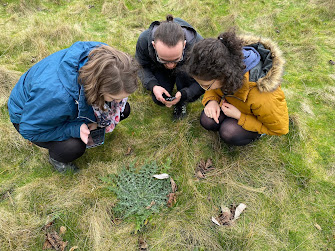The first bumblebee of the year
 |
| My first 2022 bumblebee (6th March 2022) |
The huge buff-tailed bumblebee queens are out of hibernation ready to start making their nests in time for all the spring flowers to come out. A rather appropriate anniversary gift for my Graham and I!
The large queen bumblebees start flying on sunny days in early spring (some are winter-active). They are searching for food high in energy (nectar) and protein (pollen). You can see the neat-packed pollen baskets on bumblebee's hind legs and nectar is stored in their crop (similar to where birds store food). Sometimes the colour of the pollen can suggest what plant a bee has been visiting; I occasionally notice bumblebees with striped pollen baskets from visiting different flowers (see photo below). |
| Bumblebee with two types of pollen on hind leg |
Once fed, the bumblebee will be seen low flying (zig-zagging pattern) across habitats like grass verges, near compost heaps, and other habitats which may provide possible nesting holes. Most UK species of bumblebee will nest in abandoned mammal holes, but the Tree Bumblebee (naturalised from Europe arriving in 2001) has exploited a niche nesting in tree cavities and bird boxes.
The queen bumblebee will start collecting food for the nest and lay eggs for worker bees; once mature, the workers will take over jobs like foraging and nest maintenance. This allows the queen to lay more eggs and expand her colony size over the summer.
In late summer, she will lay eggs which will develop into males and new queens. These will leave the nest and mate with other bumblebees from the same species (but different colonies). Mated queens will then begin hibernation and the males die. The cycle begins again with these queens coming out of hibernation the next year.
Here is a neat diagram of a bumblebee lifecycle from Xerces Society:
 |
| Bumblebee lifecycle diagram from Xerces Society |
Planting for Pollinators (and Bees)
It is really important to make sure that there are some pollen and nectar resources now the insects are starting to appear. Early emerging bumblebee queens will often use Willow catkins and early flowering plants such as the Mahonia above. Blooms for Bees, The Wildlife Trusts, Bumblebee Conservation Trust, Friends of the Earth, Sussex University, and BeeWatch have a good summary of plants for early queens and through the rest of the year.
If you can, try to have a patch of these flowers in your garden, balcony or plant pot, or even better as a wildflower verge or meadow instead of a lawn! The BeeKind tool can be used to assess how good your green area is for pollinators and can suggest plants you might want to consider growing ready for next year.



Comments
Post a Comment